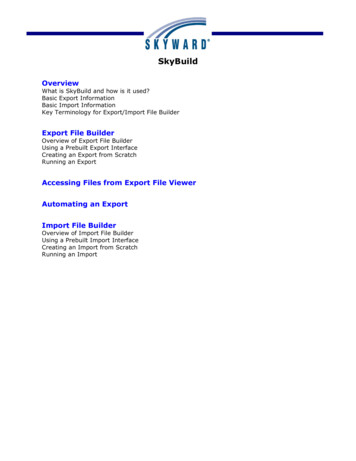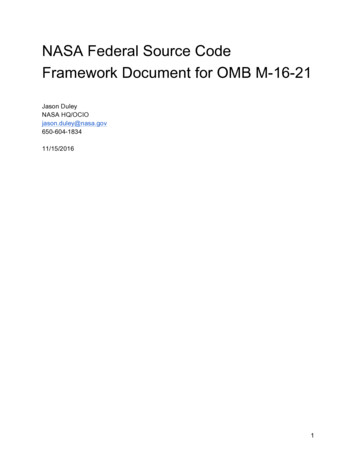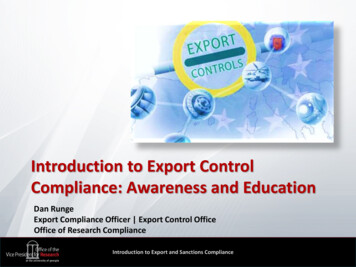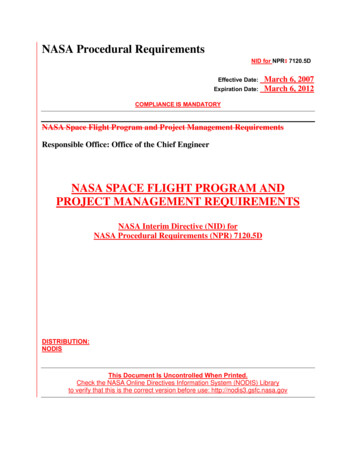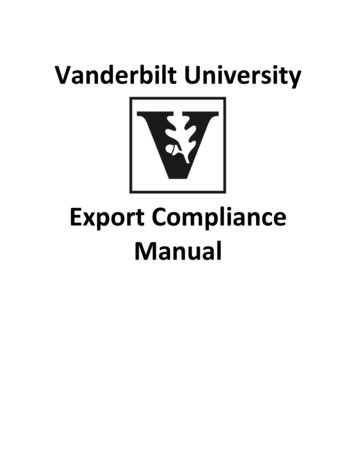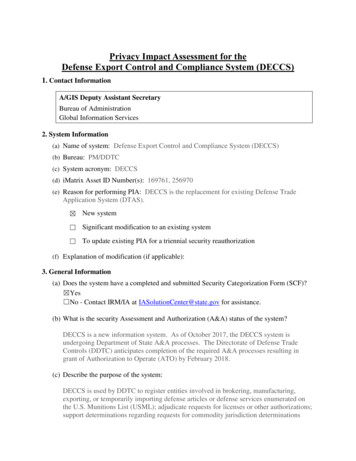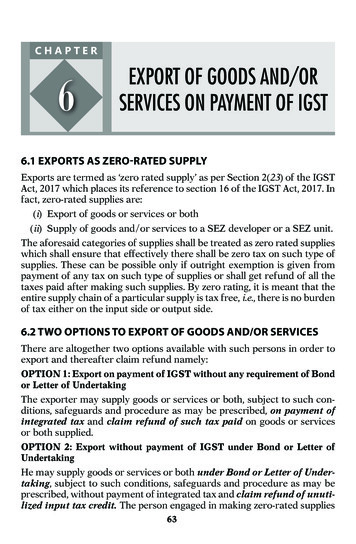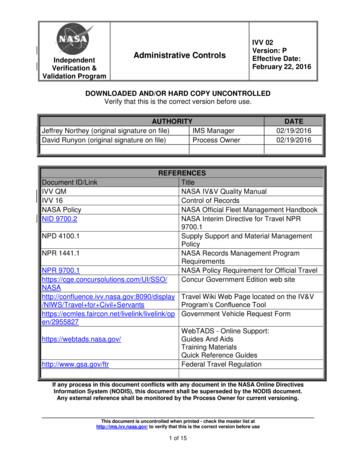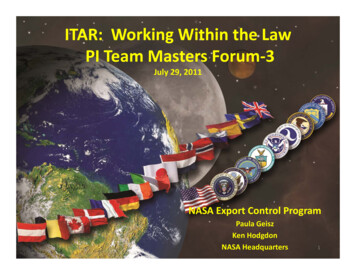
Transcription
ITAR: Working Within the LawPI Team Masters Forum‐3July 29, 2011NASA Export Control ProgramPaula GeiszKen HodgdonNASA Headquarters1
Export Control Compliance:Part of the NASA Mission “It is NASA policy to ensure that exports and transfers ofcommodities, technical data, or software to foreign personsare carried out in accordance with United States exportcontrol laws and regulations, and Administration and NASApolicy.”NPD 2190.1, Section 1.a. (May 24, 2001) “We want to maximize the benefits of our internationalefforts while ensuring that we comply with U.S. export controllaws and regulations.’ This is the personal responsibility ofeach employee.”NPR 2190.1, Section P.1. (April 10. 2003)2
Key Export Control & Nonproliferation Principles Primary Export Control Laws and Regulations– Export Administration Act; Export Administration Regulations (EAR)– Arms Export Control Act; International Traffic in Arms Regulations(ITAR)– 10 CFR 810 Department of Energy regulations– INKSNA– Office of Foreign Assets Control (OFAC) regulations– Proscribed Countries, Denied Parties, Entities List, etc. U.S. Non‐Proliferation and Export Control PolicyNational Space Transportation PolicyNational Space PolicyP.L. 106‐391 – NASA Authorization Act of 2000P.L. 112‐10 – DOD Continuing Appropriations Act of 20113
The International Traffic in Arms Regulations(ITAR)*22 CFR 120‐130*Updated via Federal Register Noticeshttp://www.pmddtc.state.gov/Authorizes the President to control the export and import of defense articles anddefense services. Authority delegated to the Secretary of State.4
United States Munitions List (USML)‐ 22 CFR 121 I ‐ FirearmsII ‐ Artillery ProjectorsIII ‐ Ammunition*IV ‐ Launch Vehicles, etc.*V ‐ Explosives, Propellants, IncendiaryAgents and Their ConstituentsVI ‐ Vessels of War and Special NavalEquipmentVII ‐ Tanks and Military VehiclesVIII ‐ Aircraft and Associated EquipmentIX ‐ Military Training EquipmentX ‐ Protective Personnel EquipmentXI ‐ Military Electronics*XII ‐ Fire Control, Range Finder,Optical and Guidance and ControlEquipment *XIII ‐ Auxiliary Military EquipmentXIV ‐ Toxicological Agents and Equipmentand Radiological Equipment*XV ‐ Spacecraft Systems and AssociatedEquipmentXVI ‐ Nuclear Weapons Design and RelatedEquipmentXVII ‐ Classified Articles, Technical Data andDefense Services Not Otherwise EnumeratedXVIII ‐ Directed Energy WeaponsXIX ‐ ReservedXX ‐ Submersible Vessels, Oceanographic andAssociated EquipmentXXI ‐ Miscellaneous Articles5
USML Cat XV Spacecraft and Associated Equipment– All spacecraft (except International Space Station)– Certain GPS Receivers– Certain Rad Hard Microprocessors– Uniquely Designed, Modified, Configured Systems, Piecesand Parts for Above– Technical Data for Above6
The International Traffic inArms Regulations (ITAR)Proscribed Countries ‐ 22 CFR 126.1 If a country appears on the “proscribed country” list, it is (generally)U.S. policy to deny licenses, or other approvals, associated withexports and imports of defense articles and defense services,destined for or originating in that country ITAR License Exemptions are trumped if a “foreign person” from anyof these counties is involved; i.e., a license must be applied for.7
ITAR Proscribed Countries AFGHANISTAN (case by case)BELARUSBURMACHINA (PRC)CONGO (case by case)CUBA*CYPRUSERITREA*FIJIHAITI*INDONESIA (case by case)IRANIVORY COASTIRAQ (case by case)LEBANON LIBERIALIBYA (case by case)NORTH KOREA*PALESTINIAN AUTHORITYSIERRA LEONESOMALIASRI LANKASUDANSYRIAVENEZUELAVIETNAM*YEMEN*ZIMBABWE* Department of State has published restrictive guidance regarding these countries/entities,22CFR §126.1.8
The ITAR in Civil SpaceCommonly‐used ITAR License Exemptions123.4(a) & 126.4(a)126.4(c)126.5Temporary importsExports of parts, components, modelsTechnical data exports directed by DODTechnical data exports directed by U.S. Gov agencyTechnical data exports for lawfully exported articlesTechnical data returned to senderTechnical data disclosed to university employeesTechnical data authorized by State DepartmentDirectorate for Defense Trade Controls written exemptionPublicly available data about defense articlesPlant visitsExports by or for U.S. Gov agencyImports/Exports for use by USG agency abroadCanadian Exemptions9
NASA’s International Agreements NASA’s International Agreements – the basis for NASAforeign cooperative (or reimbursable) activity Define the responsibilities of the parties, scope of the work to beperformed, & the terms and conditions under which the cooperation will beeffected All NASA International Agreements contain clauses ontransfers of controlled goods & data NASA’s International Agreements do NOT trump exportcontrol laws & regulationsAn International Agreement does not replace acontractor’s need for a Technical Assistance Agreement10
Closing The Department of State is the regulatory authority fordefense articles and defense services.http://www.pmddtc.state.gov/ The Department of Commerce is the regulatory authorityfor dual‐use items. http://www.bis.doc.gov/ The NASA Export Control Program is athttp://oiir.hq.nasa.gov/nasaecp/index.html The Presidents Export Control Reform Initiative is athttp://export.gov/ecr/index.asp Federal Register Notice – A Proposed v11
Export Control Compliance: Part of the NASA Mission "It is NASA policy to ensure that exports and transfers of commodities, technical data, or software to foreign persons are carried out in accordance with United States export control laws and regulations, and Administration and NASA policy."

